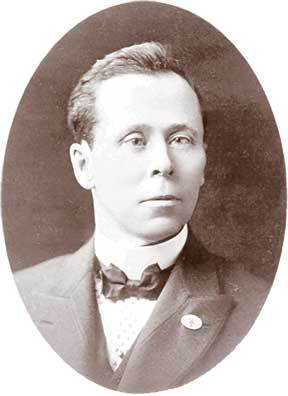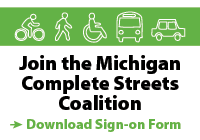
Horatio Sawyer Earle (1855–1935) is known as the "Father of Good Roads" or simply Horatio "Good Roads" Earle.
How Michigan bicyclists paved the first road in America
The Good Roads Movement, led by the “Father of Good Roads,” Michigan’s own Horatio Earle, demanded better road conditions for the growing community of cyclists across the country.
The boom of the bicycle as an object of pleasure and a symbol of progress resulted in a natural desire by bicyclists for smooth, safe roads to ride upon. This led to organized efforts to clear the roads of mud, horse droppings, and hazards like crumbling cobblestones and an unpredictable crisscross of streetcar tracks.
The Good Roads Movement banded millions of American bicyclists together at demonstrations, rallies and other political actions. With a motto of, “Where there is a wheel, there is a way,” cyclists took their campaign for better streets to the streets, quickly gaining the ears of politicians across the nation. In fact, many of those cycling advocates successfully ran for elected office themselves on platforms focused on better road conditions.
Horatio Earle, who came to Michigan in 1889, quickly became entrenched in politics, giving the Good Roads Movement a fervent supporter in our great state. Having gained a seat in the Michigan Senate, Earle pushed through legislation to create the State Highway Department, now known as the Michigan Department of Transportation.
The Good Roads Movement also successfully lobbied the Michigan Legislature to pass the County Road Act of 1893, which permitted each county, by a vote of the people, to establish its own county road commission and levy a road tax. All but one of Michigan’s 83 counties eventually created road commissions. The state’s 82 separate road commissions unintentionally produced a perplexing system of road management, which many Michigan citizens find confusing and difficult to participate in to this day.
Horatio Earle also gave Michigan bragging rights for the world’s first mile of concrete highway. Built in 1909, Woodward Avenue between Six and Seven Mile Roads in Detroit attracted builders far and near to witness how concrete stood up under the heavy traffic loads of the period. Woodward Avenue proved a success, helping to spawn our modern highway system.
Also unintentionally, the historic fight for better bicycling set the stage for the rise of the automobile industry. Bicyclists successfully gained better surfaces to ride on, but they soon realized it that they now had to share the road with more than just other bicyclists, horses and trolleys.

Michigan historical marker commemorating Horatio Sawyer Earle in front of the Michigan Department of Transportation building in Lansing, Michigan.
The internal combustion engine created congestion and, ultimately, the first “Share the Road” campaigns. However, the political clout of cyclists waned as the automobile took the nation by storm. Membership in the League of American Wheelman slipped heavily by the turn of the 20th century as national bicycle sales dropped from 1.2 million in 1899 to 160,000 in 1909.
In the 100-plus years since our “high-wheeling” ancestors spurred our modern network of paved roads, the automobile has taken over our culture and never looked back. As people became able to live farther from work, suburbs upon suburbs sprawled farther and farther from the urban cores. City centers, once filled with life and vitality, became blighte as people moved to the “’burbs” to claim a piece of the “American Dream.”
For many Americans, the norm has become hour-long commutes along three-lane superhighways lined with strip malls and congested with single-occupancy SUVs filled with obese, road-rage-prone drivers distracted by fast food, cell phones and iPods.
Somewhere along the line, engineers, planners and politicians — following the general public — dismissed bicyclists as a fringe group. Our roads were no longer built to move people, but solely to move motor vehicles. By the end of WWII, society had redefined the bicycle as a “toy,” forgetting or even ignoring its lineage as a legitimate and efficient form of transportation.
We certainly will have to deal with a lot of problems as a society before cycling will once again be recognized as a legitimate form of transportation. Since the 1990s, however, as road cycling’s popularity has strongly rebounded, so too has bicycle advocacy. One could argue that the Good Roads Movement has been reborn in the modern-day effort to “complete the streets.”
Complete Streets means just what it says – roads designed and operated to provide safe access for all users. Pedestrians, bicyclists, motorists and bus riders of all ages and abilities are able to move along and across a complete street safely.
There is no single prescription for a complete street, but the following are key features: Sidewalks, bicycle lanes, sharrows (shared lane markings), wide shoulders, plenty of well designed and well placed crosswalks, crossing islands, mid-block crossings, bus “pull-outs” or special bus lanes, raised crosswalks, audible pedestrian signals, sidewalk “bulb-outs” (“traffic-calming” devices that narrow the street by significantly widening the sidewalk, landscaped planting strip, or parking area.), street trees, planter strips and ground cover, staggered parking and other “traffic-calming” techniques that tend to lower speeds and define an edge to travel ways, center medians with trees and ground cover, reduction in numbers of driveways, and on-street parking and other visual speed-reduction methods, when properly designed to accommodate bicycles
The Complete Streets movement has gained momentum over the past few years, drawing diverse organizations under a common umbrella. Just as cyclists want safe roads, pedestrians are strong advocates for completing our streets. The disabled, who often rely on mobility aids, also require safe access to our roadways. The American Association of Retired People (AARP) recognizes Complete Streets as key to meeting the mobility needs of their 40 million members.
Environmentalists see Complete Streets as an opportunity to reduce greenhouse gas emissions and combat urban sprawl. Public health advocates see active infrastructure as a common-sense solution for obesity and the slew of diseases caused by inactivity.
Realtors are embracing Complete Streets, because more and more prospective homebuyers want more walkable/bikeable communities. And once-blighted urban cores are now being revitalized, as developers and city planners recognize that more and more people want to drive less.
These diverse groups have collaborated on hundreds of Complete Streets efforts at the local, statewide and national levels. To date, Complete Streets policies have been adopted in more than 80 jurisdictions across the United States, including California, Illinois, and dozens of cities and counties.
In Michigan, the city of Jackson adopted a Complete Streets resolution in 2006, while the cities of Lansing and Flint are actively working toward their own local policies. At the state level, Governor Granholm recognized Complete Streets as a key ingredient to combating childhood obesity and has established a task force specifically on the issue. In addition to serving on this task force, LMB is actively working with partners such as the Michigan Environmental Council and AARP to build a diverse coalition to pass statewide Complete Streets policies.
Our national cycling advocacy counterparts are advancing Complete Streets efforts federally. Senator Tom Harkin (D-IA) and Congresswoman Doris Matsui (D, CA-5) have introduced the Complete Streets Act of 2009. The Act will “ensure that all users of the transportation system, including pedestrians, bicyclists, transit users, children, older individuals, and individuals with disabilities, are able to travel safely and conveniently on and across federally funded streets and highways.”
So, who will fill the shoes of Horatio Earle and pioneer a 21st Century gilded age of cycling? Unfortunately, we don’t yet see many politicians running on bicycling platforms. There is, however, plenty of exciting cycling advocacy underway that does require your attention and action. It remains to be seen whether Complete Streets will become the new Good Roads Movement. But, with its diverse supporters, the Complete Streets Movement has at least as much potential to create Good Roads in America once more — for cyclists and non-cyclists alike.
By John Lindenmayer, Associate Director - League of Michigan Bicyclists

 Find us on Facebook
Find us on Facebook Follow us on Twitter
Follow us on Twitter
















5 comments
Comments feed for this article
June 30, 2009 at 4:39 am
Thomas Earle
Missed a few points, read the book. Horse drawn wagons could pull twice as much, twice as fast with good roads, the obvious benefit to commerce was his main objective. Yours truly Great Great Grandson Thomas Earle
by gum.
June 30, 2009 at 4:06 pm
lindenmayer
Hi Thomas,
What a honor to have you post a reply. Thanks you!
Increased commerce was certainly an important motivation to pave the roadways. Similarly, Complete Streets today can also help increase property value and revitalize our urban cores while stimulating local economies.
I unfortunately don’t have the book, but I did find these quotes on Wikipedia from his 1929 Autobiography:
“I often hear now-a-days, the automobile instigated good roads; that the automobile is the parent of good roads. Well, the truth is, the bicycle is the father of the good roads movement in this country.”
“…the League of American Wheelmen was formed in 1879, with each state organized as a division. The League was the first organization that promoted the building of better roads. The League fought for the privilege of building bicycle-paths along the side of public highways. The League fought for the privilege of carrying bicycles in baggage cars on railroads. The League fought for equal privileges with horse-drawn vehicles. All these battles were won and the bicyclist was accorded equal rights with other users of highways and streets.”
http://en.wikipedia.org/wiki/Horatio_Earle
I can’t seem to find the actual book. I’m assuming it’s out of print? Please post any info about the autobiography and how to find it.
Thanks!
July 10, 2009 at 2:31 pm
Thomas Earle
Autobiography Of By Gum Earle : published by The State Review
Publishing Co Lansing , MI in 1929. Not many copies out there but
I believe in the state library you might find one.
I was not down playing the role of the League Of American Wheelmen
and the many other bicyclists clubs, if you could see the board of club
pins he put together over the years , over 50 of them , it was obvious
that he knew their importance in his fight for good roads .
July 10, 2009 at 3:01 pm
lindenmayer
Thanks Thomas for the info on the book. I’d love to see the board of historic club pins sometime. Do you have any photos of it? I’m sure the cycling community would love to see them as well.
June 30, 2009 at 4:40 am
Thomas Earle
But thanks for remembering a great man.